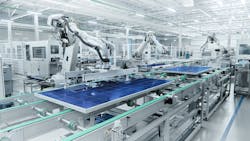Will the US renewable energy manufacturing boom help microgrids? Yes, but not yet
The US government is investing billions in renewable energy, which is good news for the microgrid industry. But don’t expect an end to solar equipment supply chain issues any time soon.
That’s the message we got from an email conversation last week with Daniel Liu, principal analyst at Wood Mackenzie and lead author of its new report that looks at how the Inflation Reduction Act (IRA) will influence investment in renewable energy manufacturing.
Investment in renewables will rise from $64 billion in 2022 to nearly $114 billion by 2031 because of the IRA, according to the report “Boom time: What the Inflation Reduction Act means for US renewables manufacturers.” The finding is significant for the growing number of developers designing microgrids that include solar panels and energy storage to achieve sustainability goals.
Liu cited two forms of tax credits in the IRA that will drive a US manufacturing boom — tax credits for manufacturers that produce renewable equipment domestically and tax credits for developers that purchase the equipment.
Caught in supply chain disruptions that hold up delivery of equipment, microgrid developers are eager to see more domestic solar manufacturing.
.But, in truth, nothing will change soon, according to Liu.
“It’s fair to assume supply chain disruptions will continue for a while. Domestic manufacturing currently supplies a small fraction of forecasted average demand to 2031. Firm and tentative manufacturing investment could provide enough capacity to supply US demand, but it takes several years to get facilities up and running,” Liu told Microgrid Knowledge.
US is way behind China
Several factors influence the timeline. First, the US has a lot of catching up to do.
Wood Mackenzie estimates that US manufacturers met just 2% of global demand for photovoltaic (PV) modules and 7% of demand for battery cells in 2021. China dominated the market, producing about 70% of PV modules and 80% of lithium-ion cells.
Exactly how much and how fast the US ramps up manufacturing depends on the interplay of two factors, according to the report:
The cost of manufacturing in the US compared with imports, taking into account the benefits of the tax credits.
The expected supply/demand imbalance for renewables equipment.
Pivotal trade ruling
US solar equipment is 6%-33% more costlier than imported equipment. But the US could become more price competitive depending on the outcome of an ongoing Department of Commerce investigation into trade activities in Cambodia, Malaysia, Thailand and Vietnam — all low-cost solar equipment suppliers.
In a preliminary ruling late last year, the Department of Commerce said that the countries were trying to bypass US duties by evading the antidumping duty (AD) and countervailing duty (CVD) orders. Companies within the four countries were getting solar equipment from China and then, after making only minor changes to it, exporting it to the US, according to the complaint. Companies in the four countries now need to certify that they are not circumventing AD/CVD orders, or they will face higher duties and import delays.
“This could potentially impact nearly 50 GW of manufacturing capacity in Southeast Asia,” Liu said.
Much of the 50 GW will be caught up in exemption applications “which adds administrative burden and uncertainty on product delivery timelines,” Liu said.
The Commerce Department is expected to issue a final ruling in May. Depending on which way it goes, tariffs could be reimposed on some importers, helping domestic manufacturing become more cost competitive.
That’s on top of the 29% cut in production costs the IRA is expected to provide to US renewable energy equipment manufacturers.
Buying strategies are key
Given the increasingly favorable economics for US production, numerous US manufacturers have announced plans to expand capacity, particularly those that produce modules. (Less certainty exists about the expansion of the supply chain into polysilicon production, wager/ingots and cell manufacturing, according to Wood Mackenzie.)
In all, the IRA incentives could cut the cost of solar, wind and storage 20% to 60%. How can microgrid developers capture those savings and navigate continued supply chain disruptions? Liu said much will depend on their buying strategies.
“Buying consortiums, like the AES consortium announced last year, will help asset owners secure equipment supply. Such consortiums may share the net benefit of the AMPC [advanced manufacturing production credit] amongst the participants, but the main rationale behind the AES consortium is to hedge against module supply shortages,” Liu said.
Bottom line: “It’s high stakes for US equipment sales, as the IRA provides incentives that cut the manufacturing cost of solar panels, storage equipment and wind towers in the US by anywhere from 4% to 30%. This, along with tariffs on some imports, potentially puts domestic manufacturing on a cost-competitive footing with imported equipment,” Liu said.
Track news about microgrids. Subscribe to the free Microgrid Knowledge Newsletter.








